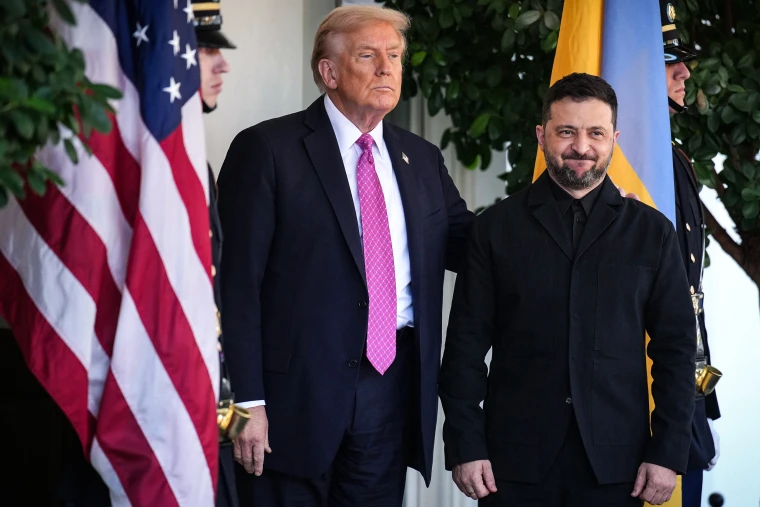On 19th November, reports leaked that the US president, Donald Trump, had proposed a new plan to his counterpart in Moscow to end the war in Ukraine. The leaked documents showed that Trump had proposed a 28-point agreement that included compromises on territory, caps on the size of the army, and amnesty for alleged Russian war crimes in Ukraine.
Soon after the initial leak, Trump also started pushing Ukraine to accept the proposed peace plan. The US president lamented that Ukraine had shown “zero gratitude” for US efforts to end the war and that Ukraine’s European allies are still dependent on Russian oil and gas exports for their energy demands despite the anti-Russia rhetoric.
In response, the Ukrainian president Volodymyr Zelensky noted that he was “personally grateful” to Trump and Washington for their military assistance.
Europe’s Response
The conciliatory tone of Zelensky, however, was not enough to lure Trump into continuing support for the Ukrainian war efforts. Instead, Trump doubled down on Zelensky and gave Ukraine the Thursday deadline to accept the terms of peace he had negotiated with President Putin. But despite the push for signing the deal, Trump’s peace plan did not survive scrutiny from the European Union (EU). Since 2022, the EU has emerged as the most fervent ally of Ukraine.
The EU has refused to compromise on Ukraine’s territorial integrity and has sought security guarantees from the United States for Ukraine by lobbying to accept Ukraine in the North Atlantic Treaty Organization (NATO). Therefore, on 23rd November, the EU dubbed Trump’s peace plan “pro-Russian” and released its own 28-point peace plan that catered less to Russian interests.
Read More: Trump Says No Firm Deadline for Russia-Ukraine Peace Deal
So, what does Trump’s vision for post-war Ukraine look like, and how has the EU responded to it? Well, here are some of the contentious provisions:
US: “Ukraine’s sovereignty will be confirmed.”
EU: “Ukraine’s sovereignty will be reconfirmed”.
US: “Ukraine will receive reliable security guarantees.”
EU: “Ukraine will receive robust Security Guarantees.”
US: “The size of the Ukrainian Armed Forces will be limited to 600,000 personnel.”
EU: “The size of Ukraine’s military to be capped at 800,000 in peacetime.”
US: “Ukraine agrees to enshrine in its constitution that it will not join NATO, and NATO agrees to include in its statutes a provision that Ukraine will not be admitted in the future.”
EU: “Ukraine joining NATO depends on consensus of NATO members, which does not exist.”
Ukraine’s Response
The Kiev administration initially remained hesitant to accept Trump’s peace proposal. However, with the leaks of major corruption scandals within the Zelensky administration at the highest level and the growing frustration of the US president, Kiev joined representatives from the US in Geneva on 23rd November to create an “updated and refined peace framework” for a lasting peace.
After the talks, the representatives of both sides expressed optimism. Speaking with the reporters at the US mission in Geneva, the US Secretary of State, Marco Rubio, said that “I think we made a tremendous amount of progress. We’ve really moved forward, so I feel very optimistic that we’re going to get there in a very reasonable period of time, very soon.”
Read More: Russia, Ukraine Trade Deadly Strikes as Pressure Mounts Over Peace Plan
On 25th November, after tough rounds of negotiations, Ukraine announced that it had reached an “understanding” with the US on the peace plan. The US President welcomed the moved and mentioned on his social media that his special envoy Steve Witkoff is set to meet the Russian President Vladimir Putin in Moscow next week to make the negotiations and finalize the deal.
Russia’s Response
The Russian response to Trump’s first deal was positive, partly because the provisions of the deal were written by the Russian authorities themselves. In the aftermath of Trump’s leaked peace proposal, many linguists claimed that the leaked proposal in English may have been translated from an earlier version written in Russian.
This led to an uproar of claims, especially by Ukraine and the EU that Trump’s proposed peace plan is pro-Russian. However, after the backlash, the US president claimed that the proposal is open to change and any final proposal would have to be agreed by Ukraine and the EU.
Though the initial deal was welcomed by Russia, the new provisions instated by US after negotiations with Ukraine and the EU are still yet to be accepted by Russia. However, Trump’s peace efforts may as well succeed in Ukraine as the peace deal is now closer than ever to be signed by all the stakeholders albeit after going through another tough round of negotiations.

Muhammad Omer Rafiq
Muhammad Omer Rafiq is a student of politics with a passion for making sense of our tumultuous political world that always seems to be on the edge. He recently graduated in International Relations from Lahore Garrison University. He can be reached at muhammadomerrafiq@gmail.com



